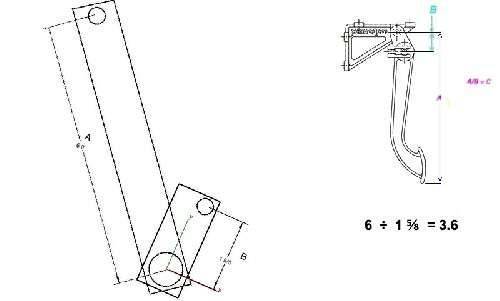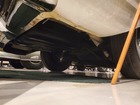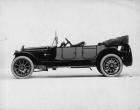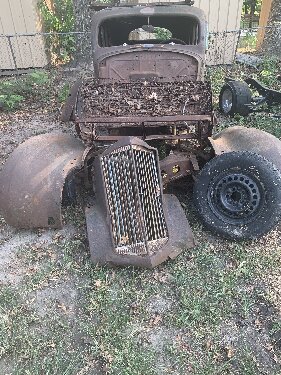|
Re: Math question
|
||||
|---|---|---|---|---|
|
Home away from home

|
Use a compass with it's point at the hinge point of the PEDAL. Draw a 1.625 radius cricle ( 3.25" diameter). Using the same center point draw a circle with a 6" radius (12" diameter).
The pedal ratio will be the ratio between the CIRCUMFRENCEs of two circles (Edit: it's like figuring a gear ratio or a belt driven pulley ratio.): Let Pi = 3.14., the geometric constant for circles. Pi * 12 = 37.68. Pi * 3.25 = 10.20. 37.68 / 10.20 = 3.7 pedal ratio. It works out the same to just divide the 6 by 1.625 = 3.7.
Posted on: 2011/3/8 23:10
|
|||
|
VAPOR LOCK demystified: See paragraph SEVEN of PMCC documentaion as listed in post #11 of the following thread:f
https://packardinfo.com/xoops/html/modules/newbb/viewtopic.php?topic_id=7245 |
||||
|
||||
|
Re: Math question
|
||||
|---|---|---|---|---|
|
Home away from home

|
THe ratio should be the same for BOTH pedal arrangements in your diagram.
Posted on: 2011/3/8 23:17
|
|||
|
VAPOR LOCK demystified: See paragraph SEVEN of PMCC documentaion as listed in post #11 of the following thread:f
https://packardinfo.com/xoops/html/modules/newbb/viewtopic.php?topic_id=7245 |
||||
|
||||
|
Re: Math question
|
||||
|---|---|---|---|---|
|
Home away from home

|
If my analysis is considered incorrect then just od it the ez way:
Get a big piece of paper and a coat hanger length 6 inches with a 1-5/8 mark near the hinge end and sweep it across the paper about 4 inches to simulate pedal movement. Take measurements and divide them.
Posted on: 2011/3/8 23:23
|
|||
|
VAPOR LOCK demystified: See paragraph SEVEN of PMCC documentaion as listed in post #11 of the following thread:f
https://packardinfo.com/xoops/html/modules/newbb/viewtopic.php?topic_id=7245 |
||||
|
||||
|
Re: Math question
|
||||
|---|---|---|---|---|
|
Home away from home

|
Keith's math looks correct to me:
6.000/1.625 = 3.6923 ~ 3.7 Craig
Posted on: 2011/3/9 2:06
|
|||
|
Nuke them from orbit, it's the only way to be sure! Ellen Ripley "Aliens"
Time flies like an arrow. Frui |
||||
|
||||
|
Re: Math question
|
||||
|---|---|---|---|---|
|
Forum Ambassador
|
Thanks for verifying the math.
One other thing if you would confirm please. In a dual setup, even though the circuits are separate and the front piston sort of floats, equal size pistons should be equal pressure to each side. With no proportioning valve and only an identical residual valve on each circuit, with the pressure taken from same spot as before (brake light switch connection) on front circuit, it would still be representative? Just want to make sure I'm not throwing a lemon in with the apples and the dual master does something funny. I was expecting to have less pressure because of the 1" diameter cylinder vs the BTV ram but was also thinking more of loss would be made up via ratio. Have a nice firm pedal but unless I still have a bleed problem, the preliminary numbers are not what I expected and don't seem to follow that reasoning completely. Will put the other booster on and compare. If that holds to same range and I confirm no bleed problem, then will have a whole new respect for BTV.
Posted on: 2011/3/9 11:10
|
|||
|
Howard
|
||||
|
||||
|
Re: Math question
|
||||
|---|---|---|---|---|
|
Home away from home

|
I'm not sure i fully understand your post, but here goes anyway:
THe Dual master cylinders are sort of funky in that the secondary (for rear brakes) piston is often (tho not necessarily) SPRING loaded to the primary piston. That means that the pressure to the rear brakes could (tho not necessarily) be less than to the front brakes. U mentioned a "bleed problem" that went away???? I'm assuming the the "bleed problem" u had was problems with bleeding the REAR brakes wheather before or after bleeding the front brakes AND no proportioning valve. If the bleed problem persists (as i am assuming it to be) then bleed the rear brakes at the wheel cylinder bleeder screws as usual BUT DISCONNECT the line for the front bakes AT THE MASTER cylinder and use a recirculation tube from the master cylinder outlet curving back into the master cylinder reservoir.
Posted on: 2011/3/9 11:28
|
|||
|
VAPOR LOCK demystified: See paragraph SEVEN of PMCC documentaion as listed in post #11 of the following thread:f
https://packardinfo.com/xoops/html/modules/newbb/viewtopic.php?topic_id=7245 |
||||
|
||||
|
Re: Math question
|
||||
|---|---|---|---|---|
|
Home away from home

|
As for the pedal ratio compensating for the increased size of the 1" piston then yes it should be about the same pressue however i haven't done the math to calculate it.
My executive is using 1" Ford dual MC and an Explorer hanging pedal assembly. I never bothered to do the math on the pedal ratio vs increased MC bore because it seems to work just fine upon first test run. What's to calculate??? Your set up appears to be about the same as any other 1" mc system (most cars are) with such a leveraged pedal arrangement. Or, to put it another way i see nothing odd or unusual proportions of your set up relative to just about every other car'lite truck on the road using relatively modern 1" mc with hanging pedal.
Posted on: 2011/3/9 11:36
|
|||
|
VAPOR LOCK demystified: See paragraph SEVEN of PMCC documentaion as listed in post #11 of the following thread:f
https://packardinfo.com/xoops/html/modules/newbb/viewtopic.php?topic_id=7245 |
||||
|
||||
|
Re: Math question
|
||||
|---|---|---|---|---|
|
Forum Ambassador
|
I didn't see that much mechanical difference from conventional vs rotary lever either. The BTV put out approx 200 psi with 100 into pedal, no vacuum. The dual is doing about 150. I have several ratios available, current max being the 3.7 and started with less ratio say about 2.5 which by my calculations with that ratio and 1" should have resulted in around 300 out with 100 in (ratio 2.5 x force 100 / diameter or .785 = 318). The numbers with vacuum should also be higher than BTV but are not-- hence the questions about ratio calculation and master cylinder effect.
Another thought: Is there anything in the method or geometry of moving long lever that could change the ratio. I can't see it and am going under the assumption that as long as the lever connect point is at the distance to provide a given ratio, it doesn't matter what the shape of connection piece to pedal is. Currently instead of straight across, I have an "L" shaped piece between pedal and lever. Intent is to lower so all inside is as close as possible to original. With pedal relaxed, long side of "L" starts about halfway up lever and drops down to just above the shaft at full pedal. Height varies depending on ratio selected. All works beautifully with plenty of range--it's just the low numbers that are confusing the issue and making me rethink. I did have some bleed problems so went to a pressure bleeder --maybe without total success-- so will try your method. It may have to wait until I get someone to help. Crawling in and out and under to pedal and bleed screws doesn't work well anymore.
Posted on: 2011/3/9 12:01
|
|||
|
Howard
|
||||
|
||||
|
Re: Math question
|
||||
|---|---|---|---|---|
|
Home away from home
|
why bother drawing circles and calculating between circumference and diameter? The ratio of two circles' diameters is the same as the ratio of their circumferences.
C1/C2 = pi*D1/pi*D2 = D1/D2
Posted on: 2011/3/9 12:42
|
|||
|
||||

 (22.61 KB)
(22.61 KB)







